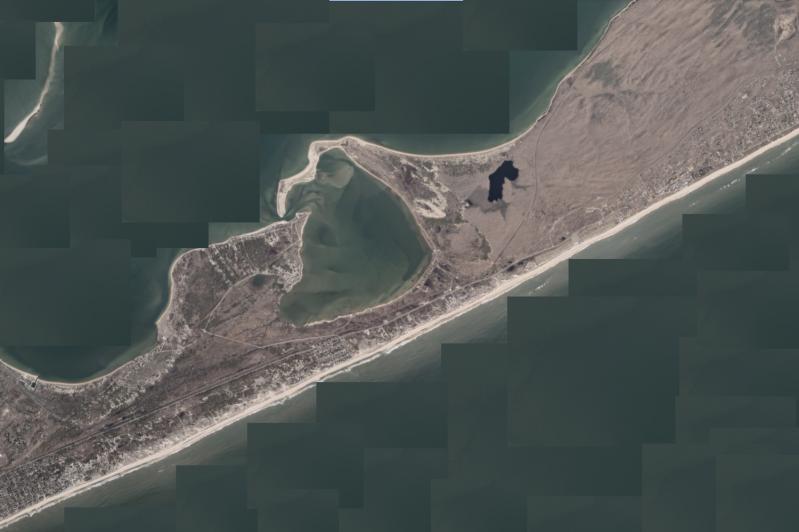Following years of discussion, the East Hampton Town Trustees, who have jurisdiction over most of the town’s waterways, bottomlands, and beaches outside of Montauk, have taken an initial step toward potentially opening the east channel of Napeague Harbor, which began to close early in this century and has been completely closed since 2012.
Following another long discussion at their Nov. 10 meeting, the trustees voted to allocate up to $25,000 to Drew Bennett of D.B. Bennett Engineering to prepare an application to the New York State Department of Environmental Conservation, which would have to sign off on the project.
The east inlet was historically located between Hicks Island and Goff Point. Through most of the town’s recorded history, it was the main boating entrance into Napeague Harbor, according to a history by Richard Whalen, who is at present the trustees’ attorney on an interim basis. The trustees have expressed interest in reopening it to promote water circulation within Napeague Harbor, which has seen a die-off of eelgrass and a collapse, as in other waterways on the East End, of the bay scallop population.
A reopening of the east channel, which would involve state property, would be a multimillion-dollar project almost surely requiring investment by multiple agencies. The trustees have mused about funding the project in part with money from the host community agreement among the town, the trustees, and the developers of the South Fork Wind farm. That agreement includes almost $29 million flowing to the two entities over 25 years.
Jim Grimes, a deputy clerk of the trustees, told his colleagues of a recent meeting with Mr. Bennett and Kim Shaw, director of the town’s Natural Resources Department. The consensus, he said, “was that perhaps the best way to do this is to put together an action plan, submit it knowing it’s going to be deemed incomplete, but with the goal of getting direction from the agencies of what they want, because we’ve speculated on this literally for years.”
Mr. Bennett “will bill us, basically, as he spends time on this,” Mr. Grimes said. “But I’d like to make a motion that we approve this. I’d love to see this thing get going.” Mr. Bennett is to produce “a rough schematic,” Mr. Grimes said, building on “quite a bit of legwork that’s been done on this over the years.” A proposal and application to the D.E.C. is intended to “get a reaction from them,” he said, because in previous discussions, when D.E.C. officials were working from home, “you could tell by the tone of the meeting they were half-interested in the discussion.”
Napeague Harbor is the cleanest saltwater body on Long Island, he said, “yet we can’t reliably grow scallops in there, when 40 years ago we could.” The west inlet, the only passage in and out of Napeague Harbor, is maintained by Suffolk County via periodic dredging, most recently in December 2024. “We’ve watched the quality of Napeague Harbor gradually decline, much like Lake Montauk, over the years,” Mr. Grimes said. “And I think this is something that should be very important, very real to us, as Lake Montauk should be to the town.”
“This is going to be a long haul, a fairly heavy lift,” he said, “but I’d like to get started.”
But the Peconic Estuary Partnership, which in 2011 contracted with a consultancy for a report that included a conceptual plan for restoration of the east inlet, which itself included closure of the west inlet, “may not think kindly of this project,” John Aldred, the trustees’ other deputy clerk, said. “That’s been the message that’s been received so far from the P.E.P. They’re concerned about eelgrass. They don’t think water quality is an issue that needs to be addressed.”
Mr. Aldred was less enthusiastic about Mr. Grimes’s plan than some of his colleagues. But, said Patrice Dalton, if the trustees limit the expenditure for Mr. Bennett’s services to $25,000 and can use the result to gain feedback from the D.E.C. as to their plan, “we’re in a better position with that in our hands.”
“I think we should do the study Jim wants to do,” Bill Taylor said.
“We’re really talking about trying to get something together that, in our lifetimes, gets built,” Mr. Grimes said. “But until we actually start doing something, all we’re doing is talking.”
“I just hope everybody’s eyes are open,” Mr. Aldred said. “There’s going to be a full environmental impact statement requested by the D.E.C. The county is going to have to commit to keeping that thing open. That’s going to be a huge lift. There’s a lot of huge lifts, and we’re going to be faced with one huge lift after another.”
Mr. Grimes was among a group of trustees who held an informal discussion with County Executive Ed Romaine last year, who he said was supportive of the project in theory. “It was light, it was casual,” Mr. Grimes said of the discussion. “It can’t be a ‘cocktail party’ conversation. It’s got to be something real.”
“The county executive certainly may help nudge a recalcitrant Department of Public Works to sign on to maintaining” a reopened east inlet, Mr. Aldred said, but he asked that Mr. Bennett meet with the trustees, should they agree to engage his services, “just to hear what the skeptics on the board might say, and see what he says about it. He’s the engineer. He must understand this stuff, and the difficulty of doing these things and the obstacles you are going to encounter — regulatory obstacles.”
Ultimately, the trustees voted unanimously to hire Mr. Bennett. “I’m for it, with some reluctance,” Mr. Aldred said.




